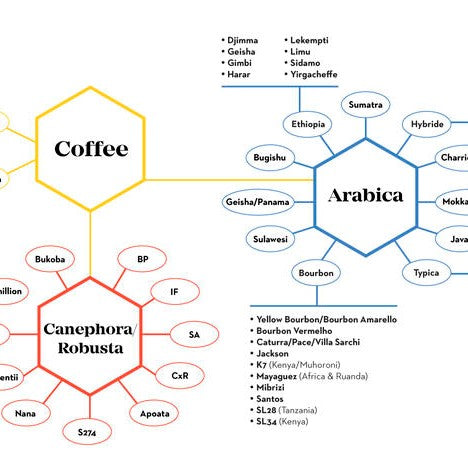
A Short Introduction to Coffee Varieties
Share
We all know and love coffee but, did you know there are countless different types of coffee beans going around, each with a unique flavor and aroma?
Let's start with your coffee. Before being roasted, whole coffee beans were pale green. Before that, they were inside a cherry; the coffee cherry. Yes - coffee beans are actually seeds, thought that's not as catchy.
Seeds of the plant Coffea, though there are many varieties in existence, some more palatable than others, some more valuable than others-- and some more profitable than others.
There are two main groups; Coffea arabica and Coffea robusta.

Arabica
The arabica beans, like the homo sapiens, originated in Ethiopia. A very old myth from an indigenous religion says that when Waqa, the god of many names, cried, a single tear fell from his eye. Where it fell, there bloomed the first coffee plant.
Incidentally, Ethiopia still boasts to this day of the most naturally occurring varieties of this plant, which are over 30 different varieties. Let’s take a look at some of the world’s preferred arabica beans:
Bourbon
French missionaries are responsible for the proliferation of this variety. It was brought over from Yemen to South and Central America, where it still is one of the most cultivated beans, particularly in Brazil.
Typica
People have been drinking Typica longer than any other variety. Originated in Ethiopia, this variety was the one introduced to Europe; Typica is, effectively, responsible for Europeans loving coffee so much that it became the worldwide sensation it is now.
Java
This variety is characterized by a very distinct, smooth flavor. It was discovered closer to our time, in the 19th century, and was quickly brought over to the new world where production was easier (and cheaper). Java is one of the most popular beans in the world and is mostly grown in Central America and Indonesia.
Mundo Novo
Literally meaning “The New World” in Portuguese, this is one of the earliest hybrids. It is a cross between Bourbon and Typica, which produced a surprisingly unique flavor and -maybe more importantly- a higher yielding plant. It is one of Brazil’s signature beans, and it makes great coffee.
Caturra
This was a naturally occurring variation of the Bourbon, with no human tinkering involved. It occurred first in Brazil, but it was quickly discovered to have a greater potential when planted in higher altitudes. It is nowadays one of the most popular beans in Central and South America, grown at high altitudes and yielding sweet coffee with many frutal tastes depending on the country.
Parainema
This is one of Honduras’ most valued coffees; it prospers in medium-to-high altitudes and it is particularly resistant to leaf rust -a disease that affects coffee plants all over the world and is a coffee farmer’s worst nightmare- and other diseases. It yields a well-balanced cup, never too bitter.
Catuai
One of the most prolific coffee crops for Central and South America, Catuai is a variety that guarantees high quality coffee, although it is very fragile and has to be attended to more than most other varieties. For this reason, only experienced, expert farmers grow this variety.
Catimor
A dwarf plant, this variety is favored by those who can manage big yields and don’t like wasting space. The Catimor allows you to grow more trees simultaneously and yields a relatively big harvest. It is mostly grown on lower altitudes, mostly in the African continent.
Indigenous Heirloom Cultivars
These are some of the oldest coffee beans around, having been traditionally grown and consumed in Ethiopia since before written history. You may have noticed that most modern beans are, in some way or another, a rather recent hybrid or modification. These beans, however, have never been tinkered with in a way that isn’t naturally. Mostly because there’s no need: the coffee made from these beans is delicious and has a rich aroma.
Then there is the Geisha/Gesha variety, a relative novelty of the world of coffee because it was only recently discovered -or, more appropriately, rediscovered- in the early 2000s. This variety, hailing from the tiny nation of Panama, went from unknown to most expensive coffee in the world at about $1000 a pound of green beans.
Though we take coffee as a given, it is important to note that the coffee plant is very, very delicate. Every year a significant percentage of the harvest is lost due to diseases exclusive to the coffee plant along with unfavorable coffee conditions. Arabica varieties are the most susceptible to diseases; some of them are more fragile than others which influences a lot what type of coffee is grown, regardless of the quality.
Robusta
The seeds of the robusta variety are, however, not that valued. They pale in comparison in terms of taste and aroma, but they have one very important thing going for them: they are more profitable.
Robusta not only endures more extreme temperatures without becoming stressed, it also needs less care from farmers. Harvests are usually more plentiful.
So-- instead of being limited to growing coffee in elevated locations, humidity, etc, this type of coffee can be grown in other locations which, though still tropical, are harsher. With a lot of shadow and the right care, you have black gold.
Robusta provides you with the taste of coffee. Not as subtle, not as rich and rather bitter, but coffee indeed. More importantly, robusta beans are high in caffeine, which is one of the main reasons many people drink coffee in the first place.
Robusta beans are either used in blends along with arabica beans to balance taste. They are also commonly used for coffee products like instant coffee, instant lattes, and other such products.